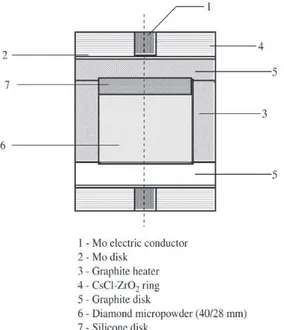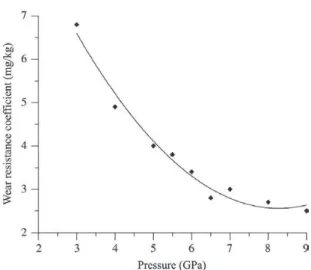Vol. 7, No. 2, 2004 Influence of High Sintering Pressure on the Microhardness and Wear Resistance of 335 Diamond Powder and Silicon Carbide-Based Composites
Materials Research, Vol. 7, No. 2, 335-337, 2004. © 2004
*e-mail: guerold@uenf.br
Articles presented at the XV CBECIMAT, Natal - RN, November de 2002.
Influence of High Sintering Pressure on the Microhardness and Wear
Resistance of Diamond Powder and Silicon Carbide-Based Composites
Oleksandr Sergueevitch Osipov, Ana Lucia Diegues Skury,
Guerold Sergueevitch Bobrovnitchii*
Laboratory of Advanced Materials – CCT, Univ. Estadual do Norte Fluminense – UENF Av Alberto Lamego, 2000 Horto, Campos dos Goytacazes, 28015-620 Rio de Janeiro - RJ, Brazil
Received: February 10, 2003; Revised: November 7, 2003
The work reported on here involved the development of several samples of “diamond-SiC” composite produced under sintering pressures of up to 9.0 GPa at temperatures of up to 1973 7K. The average size of the diamond micropowder crystals used was 40/28 µm. The sintering process
was carried out in a 2500-ton hydraulic press equipped with an anvil-type high-pressure device having a toroidal work surface and a central concavity diameter of 20 mm. The microhardness and wear resistance of the samples were found to be dependent on the sintering pressure. The experi-mental results indicated that the maximum microhardness and minimum wear resistance coeffi-cients of each compact were attained when the pressure applied during sintering exceeded 6.5 GPa. Based on the established values of pressure, this study served to identify the types of devices applicable for the manufacture of composite material inserts for a variety of rock drilling applica-tions.
Keywords: diamond powder, sintering, silicon carbide, composite
1. Introduction
The use of thermally polycrystalline diamond materials has become increasingly common in drilling bores and cut-ting tools for application in both the oil and metal-mechani-cal industries. These materials are produced by high-pres-sure high-temperature sintering of diamond micropowder with the addition of a variety of additives1-3, which become
synthesized in the diamond-silicon carbide system. Silicon, the most commonly employed additive, acts as an activator of the process4,5.
At pressures of over 3.0 GPa and temperatures exceed-ing 1573 K, the diamond micropowder undergoes a process of impregnation by the melted silicon. In the regions out-side the boundaries of contact between the diamond parti-cles (pores), the liquid phase reacts, causing the formation of silicon carbide3. This results in the production of a body
composed of a material whose structure is formed by the interpenetration of the diamond micropowder and silicon carbide particles6. This structure and the simple type of bond
formed between the silicon carbide and diamond powder during sintering render the material extremely hard, a prop-erty that remains unaltered even after heat treatment at
tem-peratures of up to 1473 K. This characteristic allows for the use of standard welding and soldering technologies in the manufacture of tools with this type of composite material, and also permits them to work efficiently under the high temperature conditions generated when operating the tool. The composition of the composite material varies ac-cording to the sintering pressure applied and the particle size of the diamond powder used. Hence, the properties and the areas of application of the composite material are also variable. However, for commercial reasons, the particulari-ties of these materials’ production processes are treated as industrial secrets. Within this context, therefore, the pur-pose of the present work was to determine the dependence of the mechanical properties of composite materials (microhardness and wear resistance) on the sintering pres-sure used in the manufacture of the “diamond-SiC” system.
2. Materials and Methods
The sintering process was carried out in a 2500-ton hy-draulic press7 equipped with an anvil-type high-pressure
con-336 Osipov et al. Materials Research
cavity diameter of 20 mm. With this setup, it is possible to use a 16 mm diameter reaction cell. Figure 1 shows a sche-matic drawing of the reaction cell.
The high-pressure device was precalibrated in order to obtain results with greater precision. The pressure was cali-brated at ambient temperature as a function of the phase transformations of the Bi I – II (2.55 GPa), PbSe (4.23 GPa) and Bi VI-VII (7.7 GPa). The pressure calibration graph was constructed based on the correlation between the pres-sure in the main cylinder of the press and the prespres-sure in-side the compression chamber. The temperature was meas-ured using a Pt/Pt-10%Rh thermocouple as a function of the electric current applied to generate heat inside the com-pression chamber. The influence of the pressure exerted on the e.m.f. of the thermocouple was not taken into account. The experiments were conducted in the following se-quence:
•
Cold compaction of the mixture at 3.0 to 9.0 GPa.•
Heating of the cell to a temperature range 1573 - 1713 K for 60 s.•
Turning off of the heating system.•
Gradual reduction of the pressure to ambient pressure.•
Disassembly of the cell and removal of the sample.•
Machining of the tip of the sample.•
Determination of the Knopp microhardness at the sam-ple’s tip using a diamond indentor with a 9.8 N load.•
Testing to determine the wear resistance coefficient. For this step, an abrasive Al2O3 cutting disk was used,and the samples and disk weighed before and after each test.
•
Calculation of the wear resistance coefficient, based on the correlation between the mass loss of the sam-ple (∆MC) and that of the abrasive disk (∆MD). Therelation (1) shown below was used for this calculation.
(1)
3. Results and Discussion
The high-pressure high-temperature sintering experi-ments yielded thirty-two 12 mm diameter and 5 mm high samples of the composite. Upon conclusion of each experi-ment, the samples were tested for microhardness and wear resistance coefficient, the results of which are illustrated in Fig. 2 and 3.
Our analysis of the influence of the sintering pressure indicated that, at values of over 6.5 GPa, the mechanical properties investigated displayed no significant variations. The microhardness reached a maximum value of 52 ± 3 GPa, tending to remain constant with increased pressure. The same behavior was displayed by the coefficient of wear resistance, which tended to remain constant at 2.9 ± 0,3 mg/kg at pres-sures of over 6.5 GPa. It should be noted, however, that these results are valid specifically for the particle size and sintering
Figure 1. High pressure cell.
Vol. 7, No. 2, 2004 Influence of High Sintering Pressure on the Microhardness and Wear Resistance of 337 Diamond Powder and Silicon Carbide-Based Composites
times employed in this study. One can therefore assume that, with particle sizes and sintering times other than those uti-lized here, the material’s microhardness and wear resistance may display a different behavior.
It has been demonstrated9 that the value of the specific
sur-face of diamond grains, as well as the mean diameter of the pores generated during the sintering process of diamond pow-der, do not vary significantly in response to pressures of over 6.0 GPa. This observation corroborates our own findings, vali-dating the results obtained from this investigation. Increased pressure in the compression chamber of the high-pressure device caused the porosity of the compacted micropowder to decrease, reducing the carbide phase content and increas-ing the diamond phase of the composite samples produced. This fact was confirmed by our X-ray analyses, which showed that, in the samples sintered at pressures of over 6.5 GPa, the SiC content remained unchanged and was approxi-mately equal to 23.5% (in mass).
A drop in the high pressure from 6.5 GPa to 3.0 GPa caused the SiC content in the structure of the sintered dia-mond-silicon carbide composite to increase from 23.5 (mass%) to 35.0 (mass%), while the contact area between the diamond grains decreased. These changes in the com-posite’s structure reduced the microhardness and increased the wear resistance coefficient of the diamond-silicon car-bide composite.
4. Conclusions
Based on the results and discussion presented herein, the following conclusions can be drawn:
•
It was shown that a correlation exists between the struc-ture and properties of the “diamond-SiC” composite material.•
Based on the conditions employed in this study, a mini-mum value was established for the sintering pressure at which it is possible to produce a two-phase (dia-mond and SiC) polycrystalline composite material with excellent mechanical properties.•
This minimum pressure (6.5 GPa) will serve as a ref-erence for the selection of the type and dimensions of high-pressure device compression chambers.Acknowledgements
The authors gratefully acknowledge the financial sup-port of FAPERJ-Brazil (Grant # E-26/170.527/2001).
References
1. Akaishi, M.; Yamaoka, S. Physical and chemical proper-ties of the heat resistant diamond compacts from diamond-magnesium carbonate system. Mat. Science and Fug.,
A 209, p. 54-59, 1996.
2. Sumiya, H.; Satoh, S. Synthesis of polycrystalline dia-mond with new non-metallic catalyst under high pres-sure and high temperature. Journal of Refractory Metals and Hard Materials, n. 17, p. 345-350, 1999.
3. Brookes, E.J.; Harris, T.K.; Al-Watban A. The determination of the static flow stress of polycrystalline diamond -SYNDAX3. Industrial Diamond Review., n. 2, p. 51-55, 1997.
4. Tomlinson, P.N.; Pirkin, N.I.; Lammer, A.; Burnard, K.P..
High performance drilling – SINDAX3 shows versatility. Industrial Diamond Review., n. 6, p. 255-304, 1985.
5. Voronin, G.O.; Osipov, O.S.; Shul’zhenko, A.A. Diamond and silicon carbide-based composite for application in rock drilling borers. Mineralogitcheskii Journal. Kiev,
n. 6, p. 90-95, 1995.
6. Shul’zhenko, A.A.; Voronin, G.O.; Osipov, O.S. Ukraine patent # 1680, ICL C01 B 31/06, C01 B 31/36. O método da obtenção de material compósito à base de diamante e carboneto de silício. Pedido 20.06.1989, publicado
25.10.1994. Boletim n. 4.
7. Bobrovnitchii, G.S.; Carvalho, E.A. Influência da precisão do sistema “prensa-dispositivo de alta pressão” nas condições de produção de materiais superduros. Anais
do IV Congresso Íbero-Americano de Ingenieria Mecânica, CIDIM-99., v. 1, p. 153-157, 1999.
8. Verestshagin, L.F.; Khvostantsev, L.G. Patent USA, n. 3854854, ICL B30 11/32. High pressure producing ap-paratus. Publ. 17.12.1974.
9. Shul’zhenko, A.A.; Gargin, V.G. et al.Diamond-based polycrystalline materials. Ed. Naukova Dumka, Kiev,
p. 150, 1989. Figure 3. Dependence of the diamond-SiC composite’s wear

